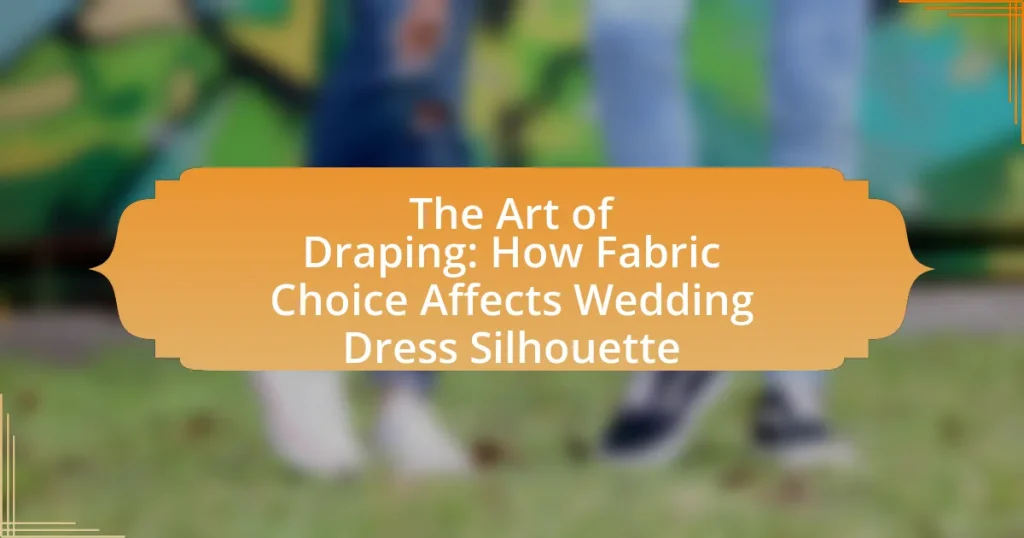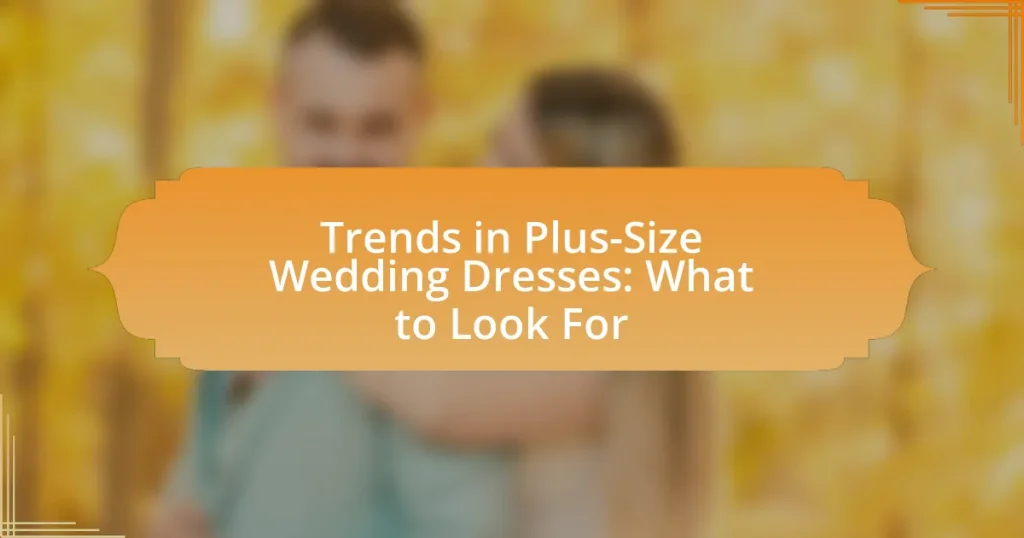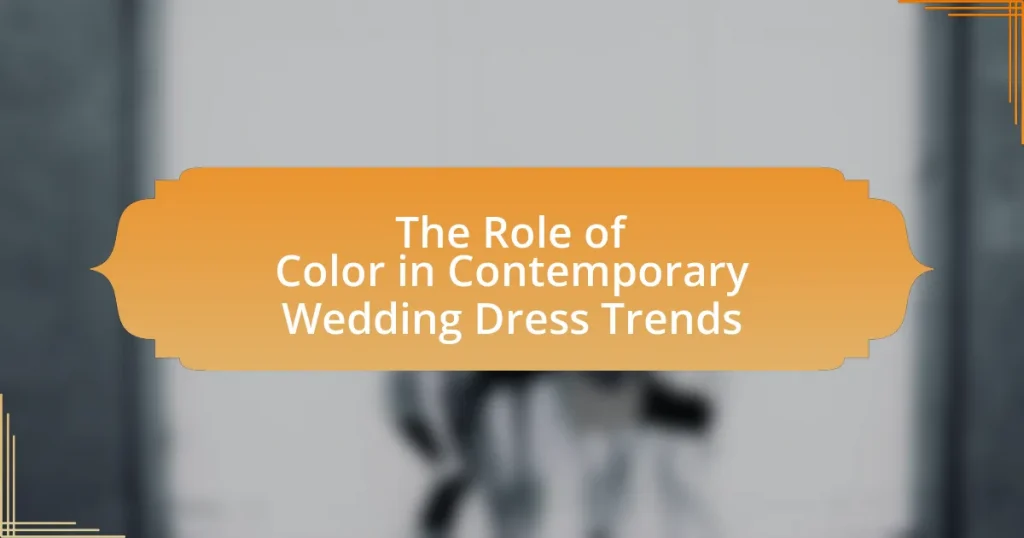The article focuses on the art of draping in wedding dress design, emphasizing how fabric choice significantly impacts the silhouette of a gown. It explores the techniques of draping, including the manipulation of fabric to create three-dimensional shapes, and discusses the influence of different fabrics—such as satin, chiffon, and lace—on the overall aesthetic and fit of the dress. Key elements of draping, including weight, texture, and structure, are examined, along with practical tips for designers on selecting appropriate materials and avoiding common mistakes. The article highlights the importance of understanding fabric behavior to achieve desired silhouettes and enhance the comfort and movement of wedding dresses.
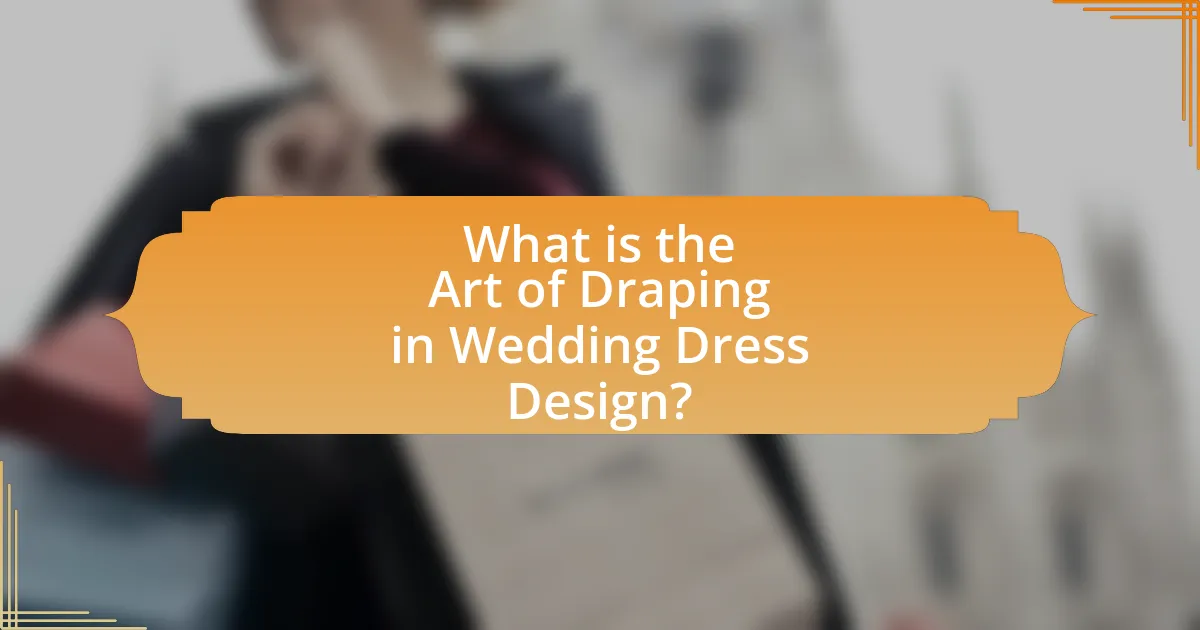
What is the Art of Draping in Wedding Dress Design?
The art of draping in wedding dress design involves the technique of arranging fabric on a dress form to create a three-dimensional silhouette. This method allows designers to visualize how different fabrics interact with the body, enabling them to manipulate the material to achieve desired shapes and styles. Draping is essential for understanding how weight, texture, and flow of fabric influence the overall aesthetic of the gown, ultimately affecting the final silhouette. This technique has been utilized by renowned designers, such as Charles James, who famously used draping to create sculptural forms in fashion, demonstrating its significance in achieving innovative and elegant designs.
How does fabric choice influence the overall silhouette of a wedding dress?
Fabric choice significantly influences the overall silhouette of a wedding dress by determining how the dress drapes, flows, and holds its shape. For instance, heavier fabrics like satin and taffeta create structured silhouettes, enhancing formality and shape retention, while lighter fabrics such as chiffon and organza offer a more ethereal and flowing appearance, resulting in softer lines. The weight and texture of the fabric directly affect the dress’s ability to maintain its intended silhouette; for example, a ball gown made from a stiffer fabric will have a more pronounced shape compared to one made from a soft, flowing material. This relationship between fabric and silhouette is crucial in bridal design, as it allows designers to achieve specific aesthetic goals and cater to different body types and styles.
What are the key elements of draping in fashion design?
The key elements of draping in fashion design include fabric selection, silhouette creation, and the manipulation of garment structure. Fabric selection is crucial as different materials behave uniquely, affecting how they fall and shape the body. Silhouette creation involves the strategic arrangement of fabric to enhance or alter the wearer’s form, which is essential in achieving desired aesthetics, particularly in wedding dress design. Manipulation of garment structure refers to techniques such as folding, tacking, and pinning, which allow designers to explore three-dimensional forms and textures. These elements collectively influence the overall design and functionality of the garment, making draping a fundamental skill in fashion design.
How does draping technique vary with different fabrics?
Draping technique varies significantly with different fabrics due to their unique properties such as weight, texture, and stretch. For instance, lightweight fabrics like chiffon and silk create soft, flowing drapes that enhance movement and elegance, making them ideal for romantic silhouettes. In contrast, heavier fabrics like satin and taffeta provide structure and support, allowing for more defined shapes and architectural designs. Additionally, stretchy fabrics such as jersey allow for more fitted draping techniques, accommodating body contours while maintaining comfort. These variations are essential in achieving the desired aesthetic and functionality in wedding dress designs, as evidenced by designers who select specific fabrics to manipulate drape and silhouette effectively.
Why is understanding fabric choice crucial for wedding dress silhouettes?
Understanding fabric choice is crucial for wedding dress silhouettes because the type of fabric directly influences the structure, drape, and overall aesthetic of the gown. Different fabrics, such as silk, tulle, or lace, possess unique properties that affect how a dress falls and shapes around the body. For instance, silk offers a fluid drape that enhances elegant silhouettes, while stiffer fabrics like taffeta create more structured shapes. The choice of fabric can also impact comfort and movement, which are essential for the wearer during the event. Therefore, selecting the appropriate fabric is fundamental to achieving the desired silhouette and ensuring the dress complements the bride’s figure and style.
What role does fabric weight play in shaping a dress?
Fabric weight significantly influences the silhouette and overall shape of a dress. Heavier fabrics, such as satin or taffeta, provide structure and support, allowing for defined shapes and voluminous designs, which are often desired in formal wear like wedding dresses. In contrast, lighter fabrics, such as chiffon or organza, create a softer, more flowing silhouette that drapes gently over the body, resulting in a romantic and ethereal appearance. The choice of fabric weight directly affects how the dress falls, moves, and interacts with the wearer’s body, ultimately shaping the visual impact of the garment.
How do different textures affect the draping of a wedding dress?
Different textures significantly influence the draping of a wedding dress by altering how the fabric falls and moves. For instance, heavier textures like satin and taffeta create structured silhouettes that maintain their shape, while lighter textures such as chiffon and organza allow for softer, flowing drapes that enhance movement. The weight and stiffness of the fabric directly affect the way it interacts with the body, leading to variations in the overall silhouette. Research indicates that the draping quality is also impacted by the fabric’s fiber content; natural fibers tend to drape differently than synthetic ones, with silk providing a luxurious flow compared to polyester’s more rigid structure.
What are the common types of fabrics used in wedding dress design?
Common types of fabrics used in wedding dress design include satin, chiffon, tulle, lace, and organza. Satin is favored for its luxurious sheen and smooth texture, making it ideal for structured gowns. Chiffon is lightweight and flowy, often used for overlays and soft draping. Tulle, a net-like fabric, adds volume and is commonly used in skirts and veils. Lace provides intricate detailing and a romantic touch, frequently used in bodices and sleeves. Organza is a crisp, sheer fabric that adds structure and elegance to designs. These fabrics are chosen for their unique properties, which significantly influence the silhouette and overall aesthetic of the wedding dress.
What characteristics define silk, satin, and chiffon?
Silk, satin, and chiffon are distinct fabrics characterized by their unique textures and properties. Silk is a natural fiber known for its luxurious feel, sheen, and breathability, making it ideal for elegant garments. Satin, typically made from silk or synthetic fibers, features a glossy surface and a smooth texture, providing a rich appearance and a soft drape, often used in formal wear. Chiffon, a lightweight and sheer fabric, is made from silk or synthetic fibers and is characterized by its delicate, flowing quality, which adds a romantic touch to designs. These characteristics influence the overall silhouette and draping of wedding dresses, enhancing their aesthetic appeal.
How do lace and tulle contribute to the silhouette of a wedding dress?
Lace and tulle significantly enhance the silhouette of a wedding dress by adding texture and structure. Lace, with its intricate patterns, creates visual interest and can define the bodice or sleeves, contributing to a more defined waistline and an elegant appearance. Tulle, being lightweight and airy, adds volume and can create a soft, flowing effect, particularly in skirts and overlays, which enhances the overall shape and movement of the dress. The combination of these fabrics allows for a balanced silhouette that can be both romantic and structured, catering to various bridal styles.

How do Different Draping Techniques Affect Wedding Dress Silhouettes?
Different draping techniques significantly influence wedding dress silhouettes by altering the way fabric falls and shapes the body. Techniques such as bias draping create soft, flowing lines that enhance a figure-hugging silhouette, while structured draping can produce more defined shapes, like A-line or ball gown silhouettes. For instance, the use of pleats or gathers can add volume and dimension, resulting in a fuller skirt, while asymmetrical draping can create a modern, dynamic look that emphasizes movement. Historical examples show that designers like Vera Wang have utilized these techniques to craft iconic silhouettes that resonate with contemporary bridal aesthetics.
What are the most popular draping techniques in wedding dress design?
The most popular draping techniques in wedding dress design include asymmetrical draping, cowl draping, and bias draping. Asymmetrical draping creates a dynamic silhouette by varying the fabric’s placement, often enhancing the figure’s curves. Cowl draping involves soft folds that add elegance and fluidity, commonly used in bodices and skirts. Bias draping, which utilizes the fabric’s diagonal stretch, allows for a form-fitting design that accentuates the body’s natural lines. These techniques are widely recognized for their ability to transform the overall aesthetic of wedding dresses, making them favorites among designers and brides alike.
How does asymmetrical draping create unique silhouettes?
Asymmetrical draping creates unique silhouettes by introducing varied lines and shapes that deviate from traditional symmetry, allowing for a more dynamic visual impact. This technique manipulates fabric in a way that highlights certain body features while concealing others, resulting in a distinctive and personalized look. For instance, asymmetrical hemlines or draped bodices can create an illusion of movement and fluidity, enhancing the overall aesthetic of a wedding dress. The use of this draping style has been widely recognized in fashion, with designers like Alexander McQueen and Vivienne Westwood employing it to craft innovative silhouettes that challenge conventional forms.
What is the impact of structured versus fluid draping on the overall look?
Structured draping creates a defined silhouette that emphasizes shape and form, while fluid draping offers a softer, more relaxed appearance. Structured draping often utilizes stiffer fabrics that hold their shape, resulting in a more tailored and formal look, which is ideal for showcasing architectural designs in wedding dresses. In contrast, fluid draping employs lighter, more flexible materials that cascade gracefully, enhancing movement and creating an ethereal effect. This difference in draping techniques significantly influences the overall aesthetic of the garment, with structured styles conveying elegance and sophistication, while fluid styles evoke romance and softness.
How can draping enhance the fit and comfort of a wedding dress?
Draping enhances the fit and comfort of a wedding dress by allowing the fabric to contour to the body’s natural shape, creating a more tailored silhouette. This technique involves strategically placing and folding fabric, which can accommodate various body types and movements, ensuring that the dress moves fluidly with the wearer. For instance, draping can reduce bulk in certain areas while providing support in others, leading to a more flattering appearance. Additionally, the use of lightweight and breathable fabrics in draping can significantly improve comfort, especially during long events, as they allow for better airflow and ease of movement.
What are the benefits of using draping to accommodate different body types?
Draping offers significant benefits for accommodating different body types by enhancing fit and flattering individual shapes. This technique allows designers to manipulate fabric in real-time, creating silhouettes that complement various proportions and curves. For instance, draping can emphasize the waistline for hourglass figures or provide volume for those with straight body types, ensuring that each dress is tailored to the wearer’s unique physique. Additionally, studies in fashion design highlight that draping techniques can improve comfort and movement, as the fabric can be adjusted to allow for ease of wear while maintaining aesthetic appeal.
How does draping influence the movement of the dress during wear?
Draping significantly influences the movement of a dress during wear by determining how the fabric falls and flows around the body. The way fabric is arranged and secured affects its weight distribution, which in turn impacts how the dress reacts to movement. For instance, fabrics with more structure, like taffeta, create a stiffer silhouette that holds its shape, while softer fabrics like chiffon allow for more fluidity and gentle movement. This relationship between draping and fabric choice is crucial in achieving the desired silhouette and comfort, as evidenced by designers who often select specific draping techniques to enhance the dynamic quality of the garment.
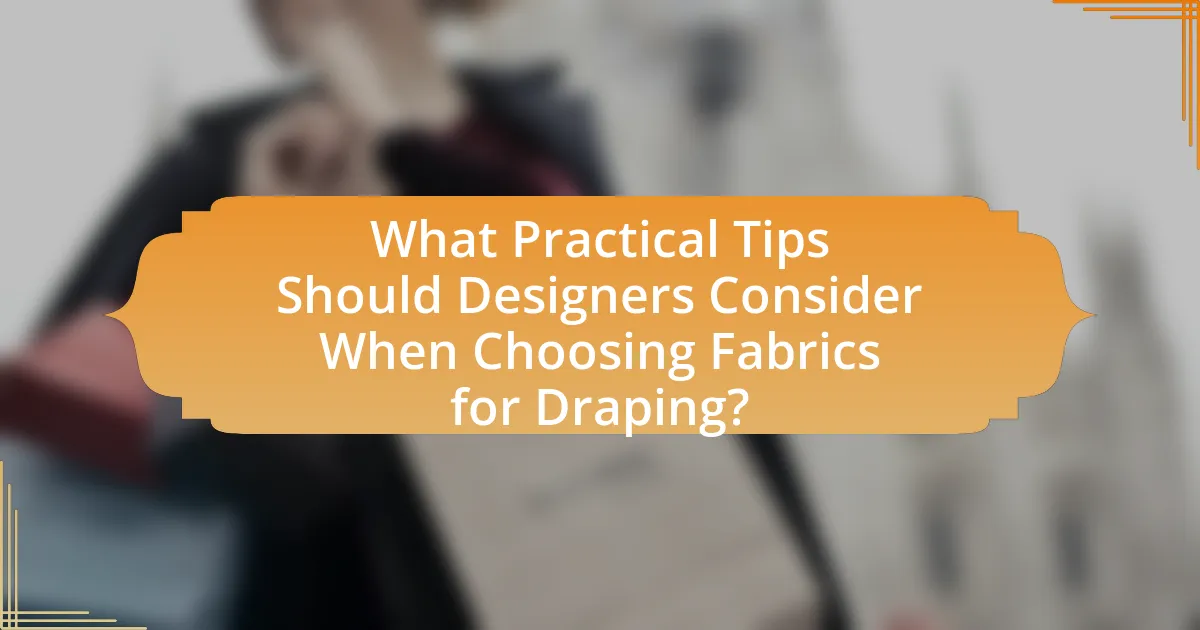
What Practical Tips Should Designers Consider When Choosing Fabrics for Draping?
Designers should prioritize fabric weight and drape when selecting materials for draping, as these factors significantly influence the final silhouette of a wedding dress. Heavier fabrics like satin or taffeta create structured shapes, while lighter materials such as chiffon or organza allow for softer, flowing designs. Additionally, designers must consider the fabric’s stretch and recovery properties; fabrics with some elasticity can enhance fit and movement, while non-stretch materials provide a more rigid form. Understanding the fabric’s behavior in relation to gravity and body movement is crucial, as it directly affects how the dress will look and feel when worn.
How can designers select the right fabric for their desired silhouette?
Designers can select the right fabric for their desired silhouette by considering the fabric’s weight, drape, and texture, as these characteristics directly influence how the fabric will fall and shape the garment. For instance, lightweight fabrics like chiffon create soft, flowing silhouettes, while heavier fabrics like satin provide structure and support for more defined shapes. Additionally, the fabric’s stretch and recovery properties can affect fit and movement, making it essential for designers to match these qualities with the intended silhouette. Research indicates that the choice of fabric can alter the perception of a silhouette, as seen in studies on garment construction and fabric behavior, which highlight the importance of fabric selection in achieving the desired aesthetic and functional outcomes in fashion design.
What factors should be considered when matching fabric with draping techniques?
When matching fabric with draping techniques, key factors include the fabric’s weight, drape, texture, and stretch. The weight of the fabric influences how it falls and shapes the silhouette; heavier fabrics like satin create structured looks, while lighter fabrics like chiffon allow for softer, flowing designs. The drape of the fabric determines how it interacts with gravity, affecting the overall movement and flow of the garment. Texture plays a role in visual interest and can impact how light reflects off the fabric, which is crucial for achieving the desired aesthetic. Lastly, the stretch of the fabric affects fit and comfort, particularly in areas requiring movement. These factors collectively influence the final appearance and functionality of the wedding dress silhouette.
How can designers test fabric draping before finalizing their designs?
Designers can test fabric draping by creating prototypes or muslins of their designs using the chosen fabric. This method allows them to observe how the fabric behaves in terms of flow, weight, and structure, which directly influences the final silhouette of the wedding dress. By draping the fabric on a dress form or model, designers can assess the visual and tactile qualities, ensuring that the fabric complements the intended design. This practice is supported by industry standards, where prototyping is a common step in the design process to validate fabric choices before final production.
What are common mistakes to avoid in fabric selection for wedding dresses?
Common mistakes to avoid in fabric selection for wedding dresses include choosing fabrics that do not complement the dress design, neglecting the dress’s silhouette, and overlooking comfort and breathability. Selecting a fabric that clashes with the intended style can lead to an unflattering appearance; for instance, heavy fabrics may not drape well for a fitted design. Additionally, ignoring the silhouette can result in a dress that does not enhance the bride’s figure, as certain fabrics work better with specific shapes. Lastly, prioritizing aesthetics over comfort can lead to an uncomfortable experience on the wedding day, as fabrics that are not breathable can cause overheating.
How can improper fabric choice affect the final silhouette?
Improper fabric choice can significantly distort the final silhouette of a wedding dress. For instance, using a stiff fabric may create an unflattering, boxy shape, while a heavy fabric can lead to sagging and loss of structure. The drape and flow of the fabric directly influence how the dress conforms to the body, affecting the overall aesthetic. Research indicates that fabrics with appropriate weight and drape, such as silk or chiffon, enhance the silhouette by allowing for graceful movement and contouring to the wearer’s shape. In contrast, fabrics lacking elasticity or structure can result in a silhouette that appears unrefined or disproportionate.
What are the signs of poor draping in wedding dress design?
Signs of poor draping in wedding dress design include uneven fabric distribution, excessive bulk in certain areas, and lack of fluidity in the silhouette. Uneven fabric distribution can create unsightly folds or creases, indicating that the fabric is not falling naturally. Excessive bulk often results from improper gathering or tacking, which can detract from the overall elegance of the dress. Additionally, a lack of fluidity suggests that the fabric does not move gracefully with the body, leading to a stiff appearance. These signs collectively indicate that the draping technique has not been executed effectively, compromising the aesthetic appeal of the wedding dress.
